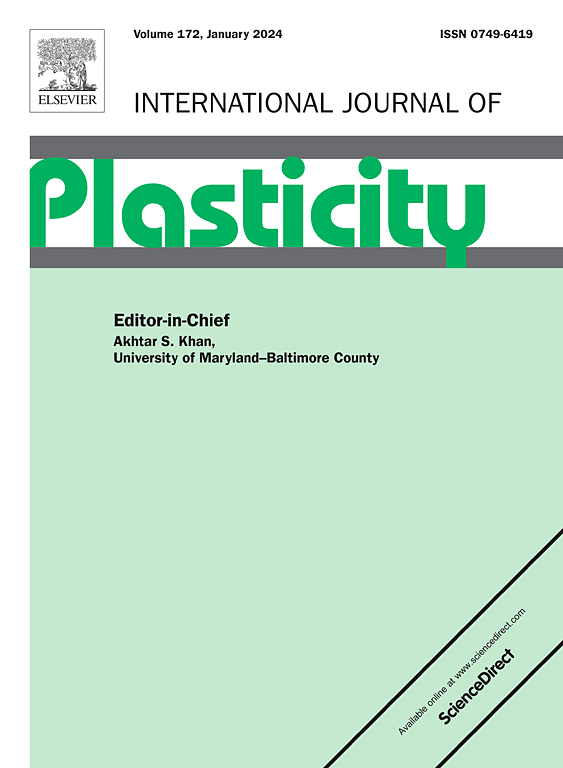Dynamic deformation and fracture of brass: Experiments and dislocation-based model
IF 9.4
1区 材料科学
Q1 ENGINEERING, MECHANICAL
引用次数: 0
Abstract
In this work, we perform a comprehensive study of the dynamic deformation and fracture of brass, including Taylor tests with classical and profiled cylinders and ball throwing experiments reaching the strain rates of about (0.1−1)/μs, as well as atomistic and continuum-level numerical modeling. Molecular dynamics (MD) simulations are used to construct the equation of state (EOS) of brass and to study its fracture characteristics at shear deformation under negative pressure. An original model of fracture under combined tensile-shear loading is formulated, which takes into account both the accumulation of empty volume in the process of lattice loosening due to the lattice defect production in the course of plastic deformation and further mechanical growth of voids controlled by the dislocation plasticity. This atomic-scale model is transmitted to the macroscopic experiment-scale level and embedded into 3D dislocation plasticity model to describe the dynamic deformation and fracture of brass using the numerical scheme of smoothed particle hydrodynamics (SPH). A part of experimental data is used to find the optimal parameters of the dislocation plasticity model by means of the Bayesian global optimization method accelerated with the help of artificial-neural-network (ANN)-based emulator of the 3D model. Another part of experimental data is used to fit the fracture model parameter. The remaining experimental data, which are not used in the parameterization, are applied to verify the parameterized model. The developed physical-based model provides correct and meaningful description of the dynamic deformation and fracture of brass, while the developed formalized approach to its parameterization opens a way to wider use of this type of models in the engineering applications, including studies on dynamic performance and high-speed processing technologies.黄铜的动态变形和断裂:实验和基于位错的模型
在这项工作中,我们对黄铜的动态变形和断裂进行了全面研究,包括传统圆柱体和异型圆柱体的泰勒试验、应变率约为 (0.1-1)/μs 的抛球试验,以及原子和连续级数值建模。分子动力学(MD)模拟用于构建黄铜的状态方程(EOS),并研究其在负压下剪切变形时的断裂特性。该模型既考虑了在塑性变形过程中由于晶格缺陷产生的晶格松动过程中空体积的积累,也考虑了由位错塑性控制的空隙的进一步机械增长。该原子尺度模型被传输到宏观实验尺度水平,并嵌入三维位错塑性模型,利用平滑粒子流体力学(SPH)数值方案描述黄铜的动态变形和断裂。在基于人工神经网络(ANN)的三维模型仿真器的帮助下,通过贝叶斯全局优化方法,一部分实验数据被用于寻找位错塑性模型的最佳参数。另一部分实验数据用于拟合断裂模型参数。其余未用于参数化的实验数据则用于验证参数化模型。所开发的基于物理的模型对黄铜的动态变形和断裂提供了正确而有意义的描述,而所开发的正规化参数化方法则为在工程应用中更广泛地使用这类模型开辟了道路,包括对动态性能和高速加工技术的研究。
本文章由计算机程序翻译,如有差异,请以英文原文为准。
求助全文
约1分钟内获得全文
求助全文
来源期刊

International Journal of Plasticity
工程技术-材料科学:综合
CiteScore
15.30
自引率
26.50%
发文量
256
审稿时长
46 days
期刊介绍:
International Journal of Plasticity aims to present original research encompassing all facets of plastic deformation, damage, and fracture behavior in both isotropic and anisotropic solids. This includes exploring the thermodynamics of plasticity and fracture, continuum theory, and macroscopic as well as microscopic phenomena.
Topics of interest span the plastic behavior of single crystals and polycrystalline metals, ceramics, rocks, soils, composites, nanocrystalline and microelectronics materials, shape memory alloys, ferroelectric ceramics, thin films, and polymers. Additionally, the journal covers plasticity aspects of failure and fracture mechanics. Contributions involving significant experimental, numerical, or theoretical advancements that enhance the understanding of the plastic behavior of solids are particularly valued. Papers addressing the modeling of finite nonlinear elastic deformation, bearing similarities to the modeling of plastic deformation, are also welcomed.
 求助内容:
求助内容: 应助结果提醒方式:
应助结果提醒方式:


